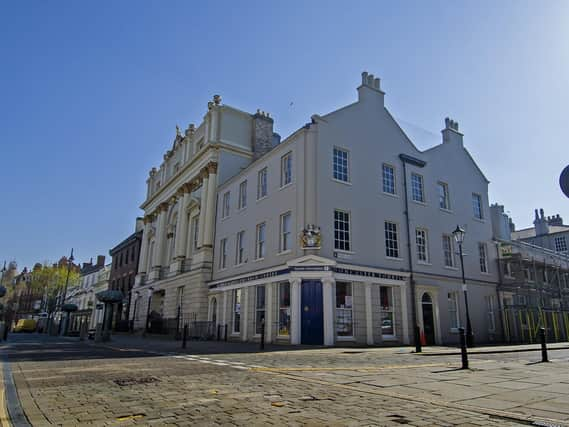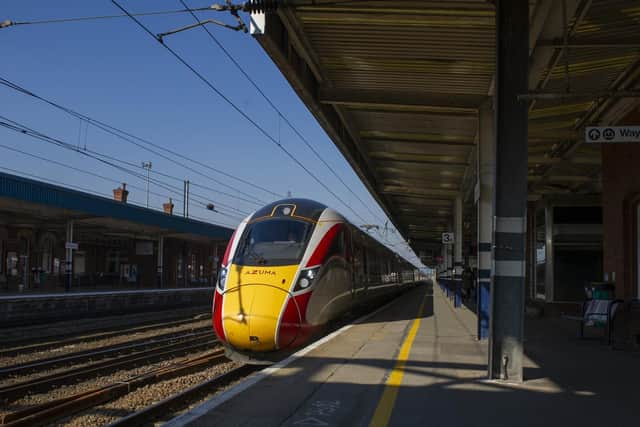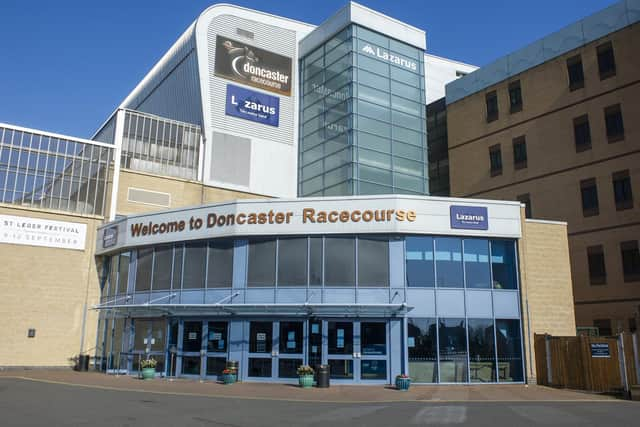Doncaster - the town built around the railway and racecourse


By a treaty that was signed in February 1136, the entire town was ceded to the Scots and their King, David I. One of England’s most inept monarchs, Stephen, who had been occupying his throne uneasily for only a year, decided that he needed to boost his image, picked a war with the folk across the border, and, in a few short weeks, lost it.
When the two men met to discuss a truce and the terms of the Treaty of Durham, Stephen agreed to hand over most of the old county of Cumberland, all of Lancashire and for some reason, Doncaster. That treaty was never revoked and the town was never formally returned. The Scots – technically, you could argue – have jurisdiction over a metropolitan borough which returns three Members of Parliament, has a population of around 320,000, and which has a central core of the town itself, plus several smaller “satellite” communities, like Bawtry, Thorne, Finningley, Conisbrough and Tickhill.
Advertisement
Hide AdAdvertisement
Hide AdToday, Doncaster is very firmly on the East Coast main line and it’s this connectivity that has established the town as an important transport hub.


The main route to the north for the legions was always Ermine Street, which led directly from Lincoln to York. Directly, that is, if you don’t factor in a little obstacle in the way – the River Humber. So the Romans effectively created a Humber Bypass, and shifted east, to a spot where a river was far easier to cross. The roots of Doncaster were planted. It was an important staging post for the Romans, and has – to a greater or lesser degree – remained one ever since.
Centuries later, Doncaster became vitally important as part of the London-to-Edinburgh stage coach route and, since the Great North Road ran straight through the town, many inns offered refreshments to travellers as their carriages stopped to change horses. There’s a tale of one innkeeper who showed a canny grasp of enterprise. He’d welcome the passengers into his rooms and put a spread on the table for them. But he also employed a group of lads who were deft in getting the fresh steeds back between the shafts. It must have been like today’s “speedy car wash”. The unwitting passengers hardly had time to get a tankard to their lips before the horn was blasted, and they had to get back on board. The food on the table had been paid for, but went untouched, and was ready for the next gullible folk to roll on in, and pay up.
These days most of the great coaching inns have disappeared, but there are a few survivors.


Advertisement
Hide AdAdvertisement
Hide AdDoncaster was also, for many years, a hugely fashionable town among the wealthy and the elite, who turned up for the celebrated race meetings – particularly the St Leger.
The stagecoaches started a lucrative trade in horse-breeding and in sales of horseflesh. Next came the races (the earliest important race in the town was run over Cantley Common in 1766) and then a dedicated racecourse, still one of the finest in the country.
And here’s another knock-on effect. The town is ringed by many fine country houses, nearly all of them built for families who could invite their guests to South Yorkshire for the racing. Effectively, these “second homes” were open for entertaining for a few weeks every year. Brodsworth Hall, just a few miles from the centre of the town, is a perfect example, and is today owned for us all by English Heritage.
The town has a deep-rooted sporting heritage. Doncaster Rovers were founded in 1879 and, while he never played for the club, Arthur Wharton – the first British black footballer – is buried in Edlington, one of Doncaster’s numerous former mining communities.
Advertisement
Hide AdAdvertisement
Hide AdAfter his career ended in 1902, Arthur became a colliery haulage worker, and battled a drinking problem. When he died in 1930, he was buried in a pauper’s grave. Following a campaign by the group Football Unites, Racism Divides, he finally got a headstone – and deserved recognition – in 1997. Once almost forgotten, Arthur’s humble plot today is rarely without flowers.
Doncaster may not be a town best known for its architecture, but it still boasts several fine buildings. Hard to miss is the imposing Grade I-listed Mansion House, which stands on the main thoroughfare. It was designed by architect James Paine, and officially opened in 1749. Strangely, Paine’s original designs show the imposing eight-pillared main block fronted by two smaller wings. These were never built, but the frontage to the fine Assembly Hall is still there, and the Mansion House itself – one of only three of its kind in England (there is another in York) – is still very much in use for civic and private functions and wedding services. It also has a thriving Friends association.
In fact, Doncaster seems to lead the way in Friends groups – there are several, looking after the interests of places as diverse as the Grand Theatre and Hyde Park Cemetery. Jay Downes, born in the town, is a member of several of the groups. “You can learn so much about the town and its heritage,” he says. “Oddly enough, I was never into history when I was at school, I found it all a bit boring. Then, on a whim one day – this would be about ten years ago – I walked into the Minster and enquired about their bell-ringing team. I joined up and was immediately impressed by the depth of knowledge people had about this area. Now I’m always reading inscriptions, asking ‘how’ and ‘why’ all the time. It’s a reminder that you can learn something new every day.”
The Grand is, sadly, listed by the Theatres Trust as being high on its “at risk” register. It opened in 1899, and was one of the first theatres in the country to be lit by electricity. Its doors closed in 1995, but the battle is on to save the structure and bring it back to life.
Advertisement
Hide AdAdvertisement
Hide AdThe cemetery may seem to be an odd thing to involve the Friends, but a local group realised that scores of the town’s leading figures found their resting place here. They include former mayors, sporting stars and engineers, and in the past few years the Friends have transformed an unloved wilderness into an important green space close to the heart of the town. Volunteers of all ages have replanted trees, got rid of weeds and litter and turned it into a thriving community asset.
One of the first buildings that travellers will see as they approach the town is Doncaster Minster, which is dedicated to St George. The original 12th century Norman building was burned down in February 1853. It, too, is Grade I listed, and was designed by Sir George Gilbert Scott. It was re-consecrated in 1858. People often wonder why it is so large, and so imposing. The story goes that in the 1850s, the Church of England was considering creating several new dioceses and was undecided as to whether Doncaster or Sheffield would get a new Bishop.
Doncaster went all out to impress, and to build big. The splendid Minster rose monumentally from the ashes, and was later described by Sir John Betjeman as “Victorian Gothic at its very best”. It had the best of everything – a clock by Dent (who also designed Big Ben), a spectacular five-manual organ by Schulze and a famed ring of eight bells. The CoE debated the Bishop issue and plumped for Sheffield, and Doncaster is still smarting from the “insult”.
It is, though, a Yorkshire town with a story on every corner. It is also one looking to the future, embracing the IT age, and with it modern engineering and manufacturing. There’s a new Civic Quarter in development, and rejuvenation and revitalisation is happening apace. Doncaster certainly has a glorious past – and, with a fair wind, its future will be just as impressive.
Advertisement
Hide AdAdvertisement
Hide AdEditor’s note: first and foremost - and rarely have I written down these words with more sincerity - I hope this finds you well.
Almost certainly you are here because you value the quality and the integrity of the journalism produced by The Yorkshire Post’s journalists - almost all of which live alongside you in Yorkshire, spending the wages they earn with Yorkshire businesses - who last year took this title to the industry watchdog’s Most Trusted Newspaper in Britain accolade.
And that is why I must make an urgent request of you: as advertising revenue declines, your support becomes evermore crucial to the maintenance of the journalistic standards expected of The Yorkshire Post. If you can, safely, please buy a paper or take up a subscription. We want to continue to make you proud of Yorkshire’s National Newspaper but we are going to need your help.
Postal subscription copies can be ordered by calling 0330 4030066 or by emailing [email protected]. Vouchers, to be exchanged at retail sales outlets - our newsagents need you, too - can be subscribed to by contacting subscriptions on 0330 1235950 or by visiting www.localsubsplus.co.uk where you should select The Yorkshire Post from the list of titles available.
Advertisement
Hide AdAdvertisement
Hide AdIf you want to help right now, download our tablet app from the App / Play Stores. Every contribution you make helps to provide this county with the best regional journalism in the country.
Sincerely. Thank you.
James Mitchinson
Editor
